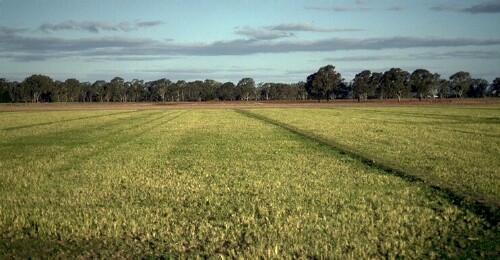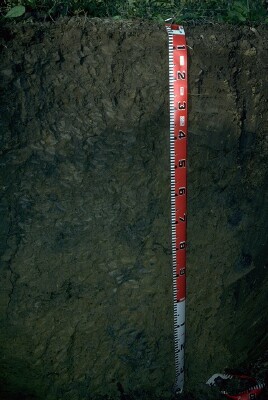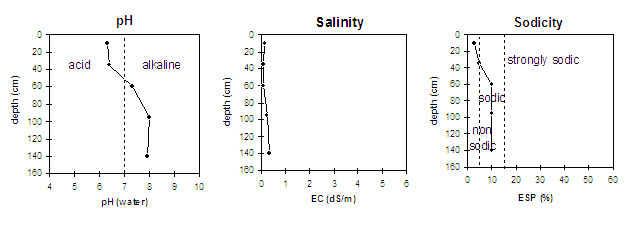LP2
| Location: Murrabit | Australian Soil Classification: |
| General Landscape Description: Flat plain. Locally referred to as Red Gum Plain. | Local Name: Murrabit Clay |
 LP02 Landscape |
Soil Profile Morphology
Surface Soil
| A1 | 0-20 cm | Dark greyish brown (10YR4/2); medium heavy clay; cracking surface condition; strong coarse prismatic, breaking down to strong fine blocky structure; firm consistence moist (subplastic when worked); pH 6.3; sharp and smooth change to: |  LP02 Profile |
Subsoil | |||
| B21 | 20-50 cm | Dark greyish brown (10YR4/2) with yellowish brown (10YR5/8) mottles; heavy clay; weak consistence moist; pH 6.4; gradual and smooth change to: | |
| B22 | 50-70 cm | Dark grey (10YR4/1) with yellowish brown (10YR5/8) mottles; heavy clay; weak consistence moist; contains very few (<2%) rounded ironstone nodules (2 mm in size); pH 7.3; gradual and smooth change to: | |
| B23 | 70-120 cm | Grey (10YR5/1) with brownish yellow (10YR6/8) mottles; medium heavy clay (becoming heavy clay with mica and fine sand with depth); coarse prismatic, breaking down to fine blocky structure; firm consistence moist; contains very few (<2%) soft manganese (2 mm in size); pH 8.0: | |
| B24 | 120+ cm | Heavy clay; contains mica; pH 7.9. | |
Key Profile Features
- Cracking surface condition.
- High clay content throughout the profile.
- Vertic properties (i.e. cracking surface condition).
Key Profile Characteristics
 |
Management Considerations:
Whole Profile
- A very positive feature of this profile is that it has a high inherent fertility throughout which is beneficial for plant growth.
Surface (A) Horizon
- When the soil is dry, heavy rains will move down soil cracks. This rapid recharge can be valuable for the survival of plants near wilting. When wet, the soil will swell and further infiltration will be relatively slow.
- Tillage of cracking clay soils should be avoided if the soil is wet (i.e. wetter than the plastic limit). At such a moisture condition, excessive tillage, trafficking or overstocking can result in structural degradation (e.g. compaction, smearing) occurring. Ideally, tillage should take place on clay soils such as these when the soil is drier than the plastic limit, down to at least the tillage depth.
- The surface (A1) horizon is non-sodic and does not disperse in water. However, there is strong dispersion after remoulding the soil and immersing it in water. This indicates that some structural degradation may occur if cultivation occurs when the soil is wet.
- The levels of total nitrogen measured at this pit site is moderate. However, this is best assessed by taking a bulked sample from across the paddock.
- The levels of organic carbon measured at the pit site is low (this may or may not be representative of the whole paddock).
- The dense and coarsely structured deeper subsoil (B22 & B23) is sodic with slight dispersion. The high exchanageable calcium levels probably aid in keeping the dispersion reduced, however, root and water movement may still be significantly restricted due to the slight dispersion and low porosity of the subsoil horizons. Fine root channels only were found in the subsoil. Restricted drainage is also indicated by the ironstone nodules and manganese in the subsoil.
- The subsoil displays vertic properties which indicates that significant shrinking and swelling occurs with wetting and drying cycles. This may disturb the roots of some plant species and has engineering implications (eg. disturbance to building foundations and fence lines).
- This soil is a riverine deposit which is indicated by the presence of mica and fine sand and overlies granodiorite bedrock at 180 cm depth. It is generally non-sodic and is not self-mulching.
- This soil floods annually and mottling in the subsoil indicates poor drainage. These soils are relatively non-permeable and therefore are not being acidified.


